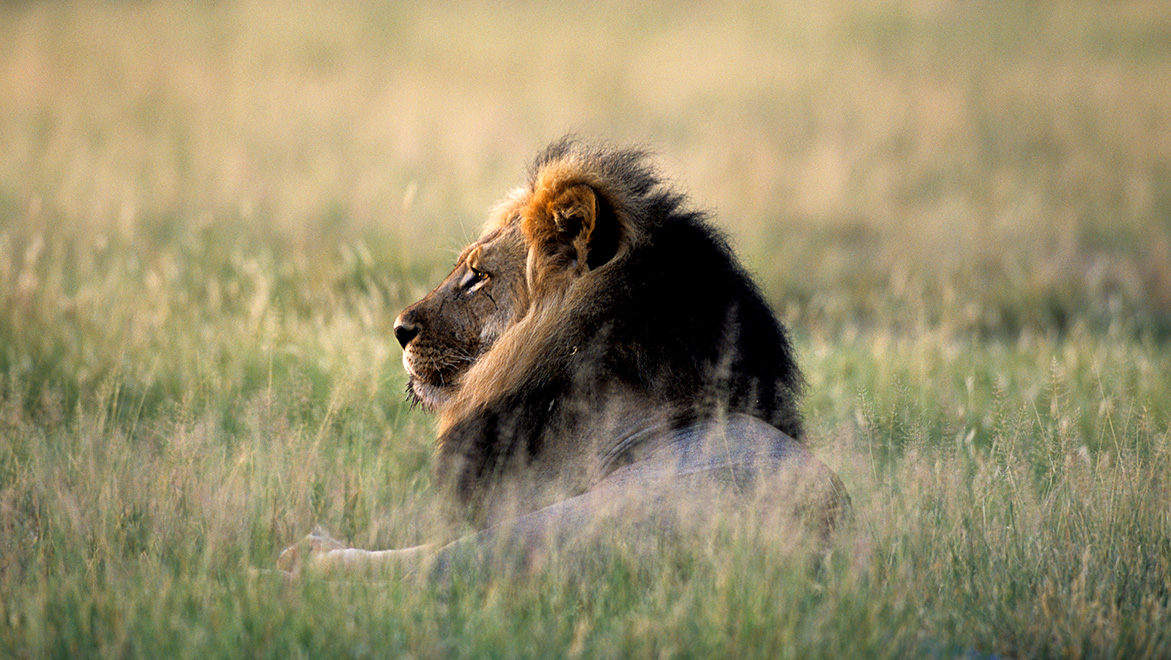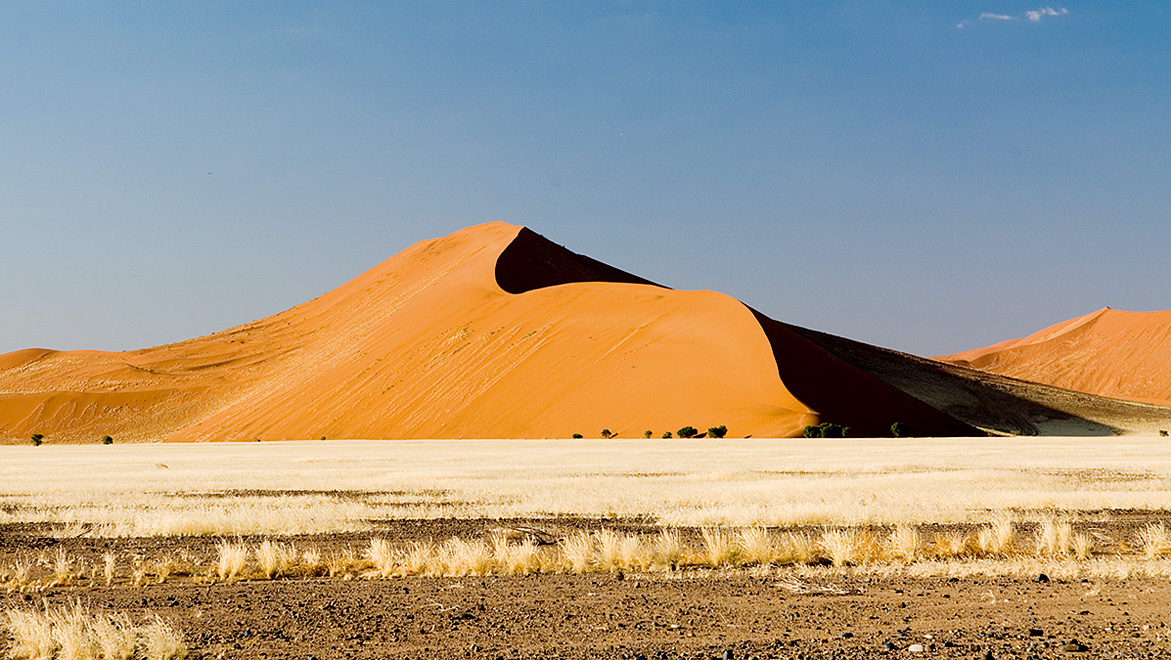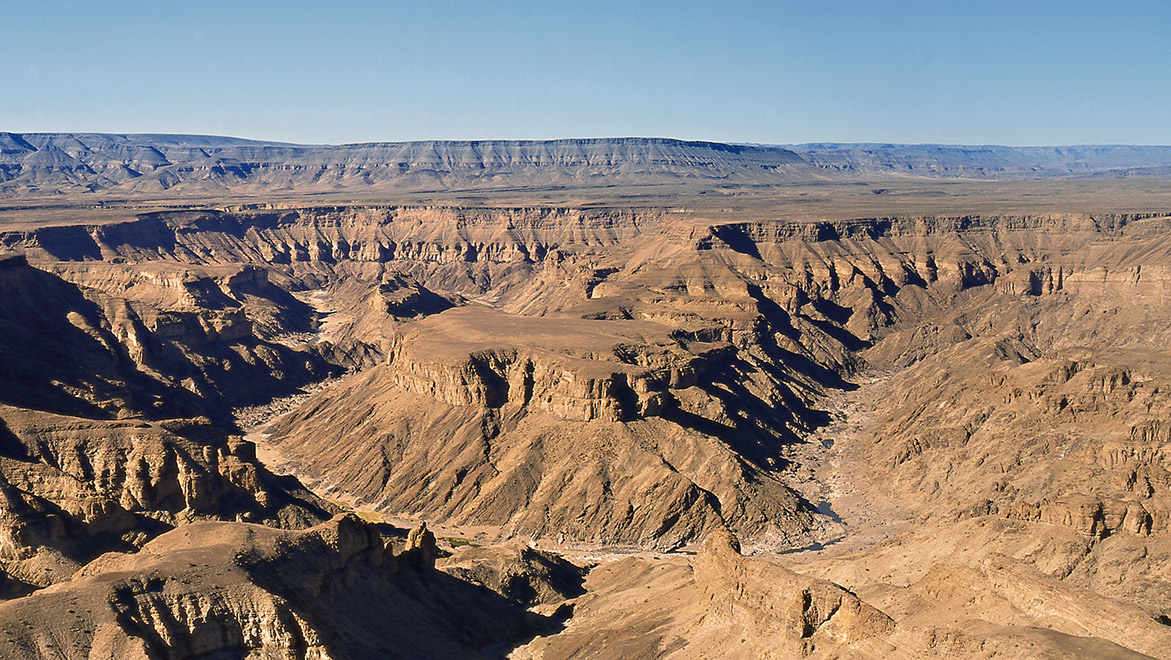Situated on the southwestern coast of Africa, Namibia borders Angola and Zambia in the north, South Africa in the south and Botswana in the east.
- World’s oldest desert and world’s highest sand dunes. The Namib is about eighty million years old, and has the world’s highest sand dunes. It is sometimes called the ‘Living Desert’ due to the wide range of its fauna.
- Rarest plant: The living fossil, Welwitschia mirabilis, endemic to the Namib Desert, is one of the oldest plants known to man.
- World’s largest underground lake: The Dragon’s Breath Lake, in the Otavi Mountains in north east Namibia, was discovered in 1986. Its surface area covers roughly five acres.
- Largest ever meteorite shower: The Gibeon Meteorite shower, which covered a 170 mi by 60 mi elliptical swath of the country’s southern portion, was discovered in 1838 by the explorer Sir J. Alexander. Specimens of the meteorite chunks can be found in museums around the world.
- Largest free-roaming cheetah population: Estimated at 2,500, which is 40-50% of the world’s total population.
- Area: Namibia covers 824,292 sq km (318,259 sq mi).
- Population: Slightly more than 2.3 million.
- Capital City: Windhoek
- Official name: Republic of Namibia
- Date of Independence: 21 March 1990
- System of Government: Multi-party Democracy
- Official Language: English. Namibia has 13 ethnic groups, 16 languages and dialects are spoken.
- Adult Literacy Rate: Adult literacy rate: 65% (female 31%, male 45%)
- Religion: Freedom of religion was adopted through Namibia's Bill of Fundamental Rights. About 90% of the population is Christian.
The Namibia Dollar (N$) is fixed to and equals the South African Rand. The South African Rand is also a legal tender in Namibia. Traveller cheques, foreign currency, VISA, Master Card, American Express and Diners Club Credit cards are accepted.
Summer time: GMT + 2 hours from the 1st Sunday in September to the 1st Sunday in April. Winter time: GMT + 1 hour from the 1st Sunday in April to the 1st Sunday in September.
Partially covered by the Namib, one of the world's driest deserts, Namibia's climate is generally very dry and pleasant. The cold Benguella current keeps the coast cool, damp and free of rain for most of the year. Inland, all the rain falls in summer (November to April). December and January are hot, when daytime temperatures in the interior can exceed 40ºC (104ºF), but nights are usually cool. Winter nights (June, July) can be freezing cold, but days are generally warm and quite nice.
Average daily temperatures:
February: 16°C - 30°C
April: 13°C - 29°C
June: 7°C - 22°C
August: 9°C - 24°C
October: 16°C - 34°C
December: 18°C - 36°C
220 volts AC, 50Hz. Outlets are of the round three-pin type.
- Nature Reserves: 15% of Surface Area
- Highest Mountain: Brandberg, 2579 m
- Other Distinct Mountains: Spitzkoppe 1728 m, Omatako 2340 m, Mt Etjo 1673 m
- Perennial rivers: Orange, Kunene, Okavango, Zambezi and Kwando/Linyanti/Chobe
- Ephermal rivers: Numerous, including Fish, Kuiseb, Swakop, Ugab and Omatako
- Big game: Elephant, lion, rhino, buffalo, cheetah, leopard, giraffe
- 20 antelope species
- 240 mammal species (14 endemic)
- 250 reptile species
- 50 frog species
- 676 bird species. Endemic birds including Herero Chat, Rockrunner, Damars Tern and Monteiro’s Hornbill.
- 14 vegetation zones
- 120 tree species
- 200 endemic plants species
- Living fossil plant: Welwitschia mirabilis
- Main Sector: Mining, Fishing, Tourism and Agriculture
- Biggest Employer: Agriculture (46%)
- Fastest-growing sector: Tourism
- Mining: Diamonds, Uranium, Gold, copper, dimension stones (granite, marble)
- Roads: 5 450 km tarred, 37 000 km gravel
- Harbours: Walvis Bay, Lüderitz
- Main Airports: Hosea Kutako International Airport, Walvis Bay Airport, Eros Airport, 46 airstrips
- Rail network: 2 382 km narrow gauge
- 6.2 telephone lines per 100 inhabitants. Direct dialling facilities to 221 countries
- obile Communication system: GSM. Agreement with 117 countries/255 networks
- Postal Service: affiliated to the Universal Postal Union
- All goods and services are priced to include value-added tax of 15%. Visitors may reclaim VAT.
- Enquiries: Ministry of Finance. Tel: +264 61 230 773
- Most tap water is purified and safe to drink
- Visitors should exercise caution in rural areas
- Public transport is NOT available to all tourist destinations in Namibia
- There are bus services from Windhoek to Cape Town/Johannesburg/Vic Falls/Swakopmund
- Namibia’s main railway line runs from the South African border, connecting Windhoek to Swakopmund in the west and Oshakati in the north.
- Due to the erratic nature of Namibia’s rainfall, the rivers in the interior of the country are ephemeral and usually dry. Runoff occurs only when the intensity of a rainstorm is high or if its duration is long enough to produce runoff.
- In terms of driving, all dry riverbeds should be considered as hazardous during the rainy season, especially when clouds are visible on the horizon.
- Devastating flash floods can occur in the period between late afternoon and early morning. Visitors should therefore never drive along a dry riverbed or camp near the river in the rainy season.
- Many of the roads in rural areas are not tarred. Dirt or gravel roads become slippery after rainfall.
- Take care under all circumstances not to drive too fast, especially on gravel roads, however safe and well maintained they look. Reduce your speed to at least 80 km/h.
- Beware also of animals on or close to the road, especially Kudu. They might suddenly dash across in front of you, especially at night which can cause fatal accidents.
While Namibia is a relatively safe and crime-free destination and has a well-trained police force, we advise visitors to take the following precautions:
- Never leave your vehicle unlocked
- Do not leave valuable items such as cameras or handbags on the seats or any visible place in your vehicle. Rather lock them in the boot.
- Make use of the official car guards wearing designated jackets at all major shopping areas.
- Do not wear expensive jewellery
- Have valuable items placed in the safe of the establishment where you are staying
- Do not open your wallet when you are in the street.
- Do not wander around on your own late at night, particularly in the more deserted suburbs.


